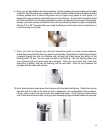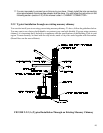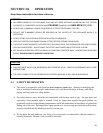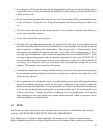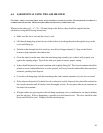
29
decorative fireplaces. Decorative fireplaces generally have larger, cooler, and less air-tight fireboxes.
Your Drolet stove, on the other hand, has a smaller, completely sealed firebox which attains much higher
temperatures. It is therefore not designed to support excessive heat caused by the addition of chemicals
in manufactured logs. Manufactured logs made of 100% wood residues do not cause any threat to your
stove. You must however be careful. Manufactured logs typically release a much larger heat output over
a short period of time. Therefore, you cannot place a large quantity of such logs into your stove, like you
would with regular cord wood. Start with one log, and gradually increase the load to 3 or 4 logs and see
how your stove reacts. Use a chimney (flue) thermometer and make sure that temperatures remain within
the normal operating range.
3.2.2 Simple wood moisture test
Add one large piece of wood to the top of an established fire. If it starts to burn on three sides within one
minute, it is dry and seasoned and right for burning. If it turns black and starts to burn in about three minutes
or more, it is damp. If it turns black and does not start burning until five minutes or more, it is green and wet.
If it hisses at any time, the wood is soaked and will not burn until the excess of moisture is boiled away.
3.3 NOTES ABOUT FIRST FIRING
The fresh paint on your stove needs to be cured to preserve its quality. Once the fuel load is properly ignited,
only burn small fires in your stove for the first four hours of operation. Never open the air control more than
necessary to achieve a medium burn rate. Make sure that there is enough air circulation while curing the stove.
Open one or more windows. The odours can be smelled during the 3 or 4 first fires. Never start your stove
outside.
3.4 LIGHTING A FIRE
• Place enough crumpled balls of newspaper or other paper into the stove to cover thbottom of the
firebox.
• Place small and dry kindling on the crumpled paper.
• Place larger and dry kindling on top of the small kindling.
• Open the air intake control fully.
• Light a fire at the bottom of the crumpled paper and close the door. If the fire tends to go out
momentarily, hold the door slightly ajar to activate the fire. As soon as the fire catches hold, close the
door.
• Ideally the large kindling should be burned until a thick bed of red embers is obtained. At that point,
add cord wood fuel and continue to operate the draft control wide open until the fire is well
established. Once the firebox is hot, the air control can be partially closed. After 30 minutes to one



